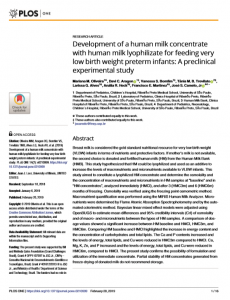
Abstract
Breast milk is considered the gold standard nutritional resource for very low birth weight (VLBW) infants in terms of nutrients and protective factors. If mother’s milk is not available, the second choice is donated and fortified human milk (HM) from the Human Milk Bank (HMB). This study hypothesized that HM could be lyophilized and used as an additive to increase the levels of macronutrients and micronutrients available to VLBW infants. This study aimed to constitute a lyophilized HM concentrate and determine the osmolality and the concentration of macronutrients and micronutrients in HM samples at “baseline” and in “HM concentrates”, analyzed immediately (HMCI), and after 3 (HMC3m) and 6 (HMC6m) months of freezing. Osmolality was verified using the freezing point osmometric method. Macronutrient quantification was performed using the MIRIS Human Milk Analyzer. Micronutrients were determined by Flame Atomic Absorption Spectrophotometry and by the automated colorimetric method. Bayesian linear mixed effect models were adjusted using OpenBUGS to estimate mean differences and 95% credibility intervals (CrI) of osmolality and of macro- and micronutrients between the types of HM samples. A comparison of dosage values showed a significant increase between HM baseline and HMCI, HMC3m, and HMC6m. Comparing HM baseline and HMCI highlighted the increase in energy content and the concentration of carbohydrates and total lipids. The Ca and P contents increased and the levels of energy, total lipids, and Cu were reduced in HMC3m compared to HMCI. Ca, Mg, K, Zn, and P increased and the levels of energy, total lipids, and Cu were reduced in HMC6m, compared to HMCI. The present study confirms the possibility of formulation and utilization of the immediate concentrate. Partial stability of HM concentrates generated from freeze-drying of donated milk do not recommend storage.
Access the original article and any supplementary material here.